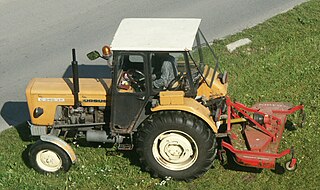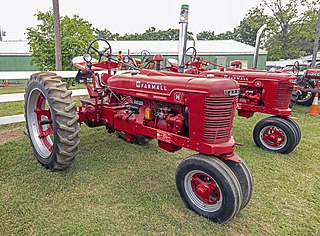
A tractor is an engineering vehicle specifically designed to deliver a high tractive effort at slow speeds, for the purposes of hauling a trailer or machinery such as that used in agriculture, mining or construction. Most commonly, the term is used to describe a farm vehicle that provides the power and traction to mechanize agricultural tasks, especially tillage, and now many more. Agricultural implements may be towed behind or mounted on the tractor, and the tractor may also provide a source of power if the implement is mechanised.

Massey Ferguson Limited is an American agricultural machinery manufacturer. The company was established in 1953 through the merger of farm equipment makers Massey-Harris of Canada and the Ferguson Company of the United Kingdom. It was based in Toronto, then Brantford, Ontario, Canada, until 1988. The company transferred its headquarters in 1991 to Buffalo, New York, U.S. before it was acquired by AGCO, the new owner of its former competitor Allis-Chalmers. Massey Ferguson is among several brands in a portfolio produced and marketed by American industrial agricultural equipment conglomerate AGCO and a major seller in international markets around the world.

The three-point hitch is a widely used type of hitch for attaching ploughs and other implements to an agricultural or industrial tractor. The three points resemble either a triangle, or the letter A. Three-point attachment is the simplest and the only statically determinate way of joining two bodies in engineering.

The Chrysler flathead engine is a flathead automotive engine manufactured by the Chrysler Corporation from 1924 through the early 1960s. The flathead engine came in four-,six-, and eight-cylinder configurations and varying displacement, with both a cast iron and cast aluminum cylinder head. It was installed in Chrysler, DeSoto, Dodge and Plymouth branded vehicles.

Fordson was a brand name of tractors and trucks. It was used on a range of mass-produced general-purpose tractors manufactured by Henry Ford & Son Inc from 1917 to 1920, by Ford Motor Company (U.S.) and Ford Motor Company Ltd (U.K.) from 1920 to 1928, and by Ford Motor Company Ltd (U.K.) from 1929 to 1964. The latter also later built trucks and vans under the Fordson brand.

The Ferguson-Brown Company was a British agricultural machinery manufacturing company formed by Harry Ferguson in partnership with David Brown.

The Ferguson TE20 is an agricultural tractor designed by Harry Ferguson. By far his most successful design, it was manufactured from 1946 until 1956, and was commonly known as the Little Grey Fergie. It marked a major advance in tractor design, distinguished by lightweight, small size, manoeuvrability and versatility. The TE20 popularised Harry Ferguson's invention of the hydraulic three-point hitch system around the world, and the system quickly became an international standard for tractors of all makes and sizes that has remained to this day. The tractor played a large part in introducing widespread mechanised agriculture. In many parts of the world the TE20 was the first tractor to be affordable to the average farmer and was small and light enough to replace the draft horse and manual labour. Many TE20s remain in regular use in farming and other work and the model is also a popular collector's item for enthusiasts today.

Farmall was a model name and later a brand name for tractors manufactured by International Harvester (IH), an American truck, tractor, and construction equipment company. The Farmall name was usually presented as McCormick-Deering Farmall and later McCormick Farmall in the evolving brand architecture of IH.

The Ford N-series tractors were a line of farm tractors produced by Ford between 1939 and 1952, spanning the 9N, 2N, and 8N models.

The Massey-Harris Model 20 was a two-plow tractor built by Massey-Harris from 1946-1948. Introduced to commemorate Massey's 100th anniversary in 1947, the 20 was virtually identical to the earlier Model 81, which first appeared in 1941. About 8,000 Model 20s were sold, in row crop or standard models, with the choice of gasoline or kerosene as fuel. The Model 20 was replaced in 1948 by the Model 22.

The Massey-Harris Model 101 was a tractor built by Massey-Harris from 1938 to 1946. Developed under the guidance of James S. Duncan, who gambled corporate losses would drop and won, the 101 introduced the Chrysler L-head inline six. The six would compete with Oliver's straight-six Model 70, while saving money on development of a whole new engine as well as taking advantage of Chrysler's existing parts and service network.
Continental Motors Company was an American manufacturer of internal combustion engines. The company produced engines as a supplier to many independent manufacturers of automobiles, tractors, trucks, and stationary equipment from the 1900s through the 1960s. Continental Motors also produced automobiles in 1932–1933 under the name Continental Automobile Company. The Continental Aircraft Engine Company was formed in 1929 to develop and produce its aircraft engines, and would become the core business of Continental Motors, Inc.

The Massey Ferguson 35 (MF35) is a tractor produced by Massey Ferguson.

The Farmall H is a medium-sized two-plow row crop tractor produced by International Harvester under the Farmall brand from 1939 to 1954. It was the most widely produced of International Harvester's "letter series", with approximately 390,000 produced over the 14-year run. It succeeded the Farmall F-20. The H was incrementally updated with new model numbers as the Super H, 300, and 350, but remained essentially the same machine. The original H used an International Harvester C152 4-cylinder in-line engine. Production of all versions lasted until 1963.

IHI Shibaura Machinery Corporation or Shibaura is a Japanese agricultural machinery manufacturer owned by IHI Corporation. The company is one of Japan’s leading suppliers of small tractors and diesel engines.

The Farmall A is a small one-plow row crop tractor produced by International Harvester under the Farmall brand from 1939 to 1947. The tractor was popular for its set of innovative features in a small, affordable implement. It succeeded the Farmall F-14. The A was incrementally updated with new model numbers as the Super A, 100, 130 and 140, but remained essentially the same machine. Like the smaller Farmall Cub, the Farmall A features a distinctive offset engine, displaced to the left over wide-set front wheels, to allow vision straight ahead. An International Harvester C113 4-cylinder in-line engine was used for early models, increased to an IH C123 with the A-1. The most significant change was the introduction of hydraulics with the Super A. The series was produced until 1973.
The Farmall 04 series tractors are a family of row-crop tractors with four-cylinder engines, continuing the tradition of four-cylinder engines in Farmall and parent company International Harvester for general-purpose and row-crop tractors. In the early 1960s demand for more power led to the 06 series with six-cylinder engines. Four-cylinder engines were reserved for tractors equivalent to the Farmall H and smaller.

The Farmall 06 series tractors are a family of row-crop tractors with six-cylinder engines, providing greater horsepower than the parallel product line of four-cylinder Farmall 04 series tractors. Until the late 1950s, Farmall and parent company International Harvester tractors used four-cylinder engines for general-purpose and row-crop tractors. Demands for higher performance and greater horsepower led to broader use of six-cylinder engines, with the bulk of International's production moving to the larger engines. The Farmall 806 and 706 were introduced in 1963, with production running to 1967. The Farmall 1206 was introduced in 1965 as the most powerful tractor of its time, using a turbocharged diesel engine. Production of the 1206 also ran until 1967. The 06 series sold well and was regarded as extremely successful.

The Farmall eight-cylinder tractor line or Farmall 08 series was briefly produced near the end of the Farmall product run, in response to pressure to increase horsepower and to match competing brands.
The Oliver 90 series of row-crop tractors was a series of agricultural tractors produced from 1937 to 1961 by the Oliver Farm Equipment Company. Beginning with the Hart-Parr 28–44, the series was the most powerful Oliver tractor offering, capable of heavy plowing. Initial development proceeded on parallel lines, with the 28–44 offered with low and high-compression engine options that became the Oliver 90 and 99, respectively. The lines merged with the Super 99, then diverged again with the 950, 990 and 995 models. The series was produced until 1961.
















